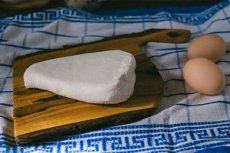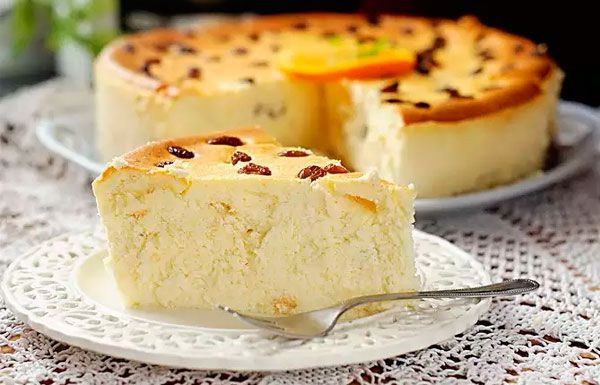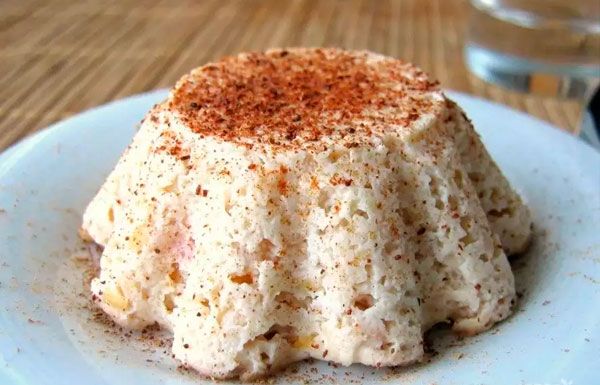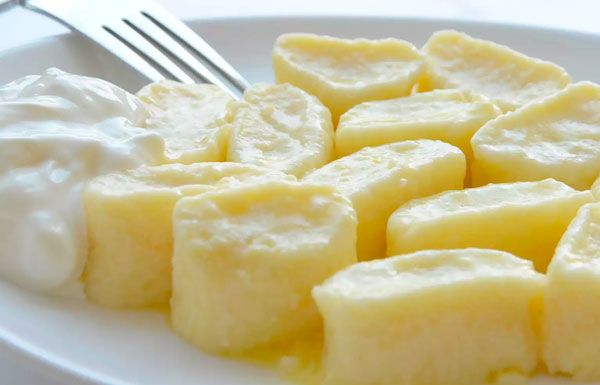
All iLive content is medically reviewed or fact checked to ensure as much factual accuracy as possible.
We have strict sourcing guidelines and only link to reputable media sites, academic research institutions and, whenever possible, medically peer reviewed studies. Note that the numbers in parentheses ([1], [2], etc.) are clickable links to these studies.
If you feel that any of our content is inaccurate, out-of-date, or otherwise questionable, please select it and press Ctrl + Enter.
Curd in pancreatitis, cholecystitis and gastritis: recipes for dishes
Medical expert of the article
Last reviewed: 04.07.2025

Cottage cheese is one of the few foods that are allowed to be consumed during periods of exacerbation of the inflammatory process in the pancreas. The protein it contains is absorbed by the body much easier than other animal proteins. Cottage cheese for pancreatitis is allowed to be eaten in combination with other food, as well as as an independent dish.
Is it possible to eat cottage cheese if you have pancreatitis?
Many people consult a doctor about whether it is possible to eat cottage cheese with pancreatitis. Nutritionists welcome the use of this product both in its pure form and as an additive to other dishes. The medicinal effect and nutritional value of cottage cheese are due to the presence of a large number of complete proteins in its composition, as well as a very important amino acid - methionine. It also combines various vitamins with microelements well.
In case of pancreatitis, it is necessary to eat only non-acidic and fresh, low-fat product. The most suitable is homemade cottage cheese. The patient should eat it in the form of paste. It is also allowed to make various dishes from it, such as soufflé and casseroles with puddings.
Sour and fatty cottage cheese is prohibited for patients with pancreatitis. In addition, it cannot be seasoned with spices, because this can provoke the production of large amounts of bile. It is also prohibited to prepare dishes from cottage cheese that require frying on both sides, using a lot of sunflower oil.
Cottage cheese for acute and chronic pancreatitis, exacerbation of pancreatitis
It is recommended to study the features of using the product in acute pancreatitis, so as not to provoke an exacerbation of the pathology or a deterioration in the patient's condition.
To avoid strain on the pancreas, you should only eat cottage cheese with a fat content of no more than 3%. In addition, the product must be fresh, ideally home-made. To make it, you need 1 liter of milk (pasteurized is recommended), which must be boiled. Then add lemon juice (0.5 lemon), wait until the milk curdles, then remove from heat and discard the contents of the container onto gauze (2nd layer). The cottage cheese will be ready when the whey has completely drained.
To avoid an increase in gastric acidity, you need to eat cottage cheese with an acidity of no higher than 170°T.
It can be consumed either pureed or in the form of steamed pudding.
To compensate for the lack of calcium, it is allowed to eat food made from the so-called calcined cottage cheese. You can make it yourself by adding calcium (you can choose chloride or lactic acid) to milk.
It is forbidden to eat cottage cheese or pudding every day. The recommended amount is no more than 2-3 times a week.
You are allowed to eat no more than 250 g of cottage cheese per day. At the same time, it is recommended to consume a maximum of 150 g of the product at a time.
During the first days, patients are often given sweet dishes - soufflé or puddings, and salty curd foods are allowed to be added to the diet later.
In case of exacerbation of chronic pancreatitis, cottage cheese should be consumed in accordance with the prescriptions offered for the acute form of the disease. When the inflammation begins to subside, and pain and signs of hypersensitivity to the product are absent (including digestive disorders - vomiting, nausea, and diarrhea), the fat content of cottage cheese can be increased to 4-5%.
During remission, it is allowed to eat 9% cottage cheese. In addition, it is allowed to eat it not only in the form of soufflé or pudding, but also mixed with pasta, cereals, and meat dishes. You can add unleavened baked goods to the menu, the filling of which will be a casserole with cottage cheese, and in addition, lazy vareniki.
If a person has started a stable remission, it is allowed to try adding dishes to their diet that include 20% cottage cheese. It is important to remember that cottage cheese with such fat content can provoke an exacerbation of the pathology if the remission was not stable enough. In addition, fatty cottage cheese slows down the process of calcium absorption, which is why the digestive system can acquire an additional load.
At the end of the fasting period, when the pathology worsens (on the 2nd-3rd day), it is allowed to add cottage cheese products to the diet. But in this case, you need to eat fractionally, not consuming cottage cheese and milk at the same time, because this can irritate the pancreas.
 [ 1 ], [ 2 ], [ 3 ], [ 4 ], [ 5 ], [ 6 ]
[ 1 ], [ 2 ], [ 3 ], [ 4 ], [ 5 ], [ 6 ]
Use in concomitant gastritis and pancreatitis
With gastritis, cottage cheese is allowed almost without restrictions, although with certain forms of pathology, this product will still not be the best choice. Most nutritionists assure that you can eat unlimited amounts of cottage cheese even in case of exacerbation of gastritis, although it should be understood that the product must be fresh and mashed. In addition, with such pathology, the soufflé form is also suitable for consumption.
Cottage cheese dishes for pancreatitis
The diet menu for pancreatitis includes curd dishes, made in the form of a paste from freshly made non-acidic curd. At the same time, it is necessary to exclude very sour or fatty curd from the dishes.
Recipes from cottage cheese for pancreatitis
A good option for pancreatitis is 4-5% non-acidic cottage cheese (or completely fat-free). It is allowed to mix store-bought dietary cottage cheese with low-fat homemade cottage cheese.
To make a homemade product, boil milk (1 l), then remove from heat and add low-fat kefir (0.5 l). If pain occurs, it is recommended to use a calcined dish, which can be purchased at a store or pharmacy.
There is also a recipe for making a dish from a fresh product. It is necessary to add 3% table vinegar (2 spoons) to heated milk (to a temperature of 60 degrees), then heat the milk to 90 degrees, and then leave for 15 minutes (to separate the whey). The cooled product must be filtered through cheesecloth.
To prepare the dish according to the following recipe, you will need calcium lactate, which can be bought at a pharmacy (in the form of tablets or powder). You need 1 teaspoon of the powder, which is diluted with boiled milk (1 l), stirring slowly. The cooled mixture is placed on a sieve. The dish can be seasoned with sweet yogurt (1 tablespoon). In addition, it is allowed to add individual fruits (non-acidic) to it - such as apples or carrots, and in addition to this, pumpkin and pears with apricots.
You can also eat salted cottage cheese - a good dietary breakfast is created by adding vegetables with herbs, as well as sour cream or low-fat kefir.
Cottage cheese casserole for pancreatitis
To prepare a cottage cheese casserole for pancreatitis, you need semolina (2 tablespoons), which needs to be soaked in water so that it swells, and in addition to this, an apple (1 piece), egg white (2 pieces), as well as cottage cheese (200 g) and vanilla with sugar to taste.
Cooking process:
- mix semolina with cottage cheese;
- add vanilla and sugar to this mixture, as well as an apple peeled and grated on a fine grater;
- beat the egg whites until foamy, then add to the mixture;
- place the resulting mixture into a mold, then bake for at least 40 minutes (temperature within 150-180 degrees);
- The finished dish should be cooled before consumption.

Steamed cottage cheese pudding for pancreatitis
To make a steamed curd pudding, you will need semolina (2 teaspoons), which is soaked in water, mashed cottage cheese (200 g), protein (1-2 pieces), and also vanillin with sugar to taste. During remissions, it is allowed to add a little butter to the dish, as well as mashed carrots.
Cooking process:
- mix all the ingredients of the dish thoroughly;
- add the egg white, beaten until foamy, to the resulting mixture;
- Next, the pudding is steamed.
Cottage cheese soufflé for pancreatitis
Diet soufflé made from cottage cheese is a great dessert for people with pancreatitis. Of course, the original product should be low-fat. This dish is quite easy to prepare, and at the same time it is very healthy for the body and tasty.
Cottage cheese for soufflé must be ground using a meat grinder, sieve or blender, and for cooking you will need a multicooker or steamer. It is allowed to add semolina, carrots stewed in milk, and cookies crumbled into small pieces to the dish.

Lazy dumplings with cottage cheese for pancreatitis
Cottage cheese for pancreatitis can be used to make lazy vareniki. They can be made according to the standard recipe, reducing only the amount of sugar added to the dish. The following option is very suitable:
To prepare, you will need low-fat cottage cheese (250 g), an egg (1 piece), flour (3-4 tablespoons), and sugar (2 teaspoons). You need to grind the egg together with the sugar, then add the cottage cheese and flour to the mixture, and then knead thoroughly. After that, wet your hands in cold water and mold a sausage from the resulting dough, which is then cut into small pieces (about 2 cm wide), and these pieces are rolled into balls. Then the dumplings are boiled in slightly salted boiling water (low boil) - after they float to the surface for about 5-7 minutes.

The finished dish needs to be cooled a little, and then seasoned with milk sauce or yogurt.
Kefir and cottage cheese for pancreatitis
In chronic pancreatitis, regardless of the stage of the pathology, it is necessary to drink kefir an hour before going to bed. This product is well absorbed by the body, perfectly satisfies hunger, and also gives the patient's stomach the necessary load.
In this case, kefir should be exclusively fat-free, and it can be drunk no earlier than 10 days after the exacerbation of the disease. The dosage is prescribed by the attending physician, with a gradual increase. The maximum daily dosage is 1 glass of kefir - it is prohibited to exceed this limit even in the case of stable remission. But during this period, the patient is allowed to switch to drinking kefir with 2% fat content.
If the required daily dosage is exceeded, damage to the mucous membrane structures and oxidation of the entire stomach contents are possible. This can cause bloating and fermentation, and then lead to a failure of the pancreas and a sharp deterioration in the patient's health.
During periods of remission, it is allowed to use kefir as a dressing for fruit or vegetable salads, as well as for boiled pasta.
During stable remission, it is allowed to add sorbitol or xylitol to kefir, as well as sugar and honey - this is possible, since during this period the pancreas functions stably, without worsening the patient's condition. It may also be allowed to add olive or sunflower oil (but only after consulting a doctor).

